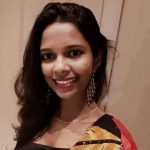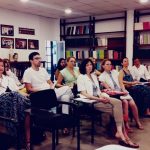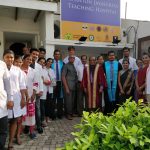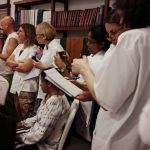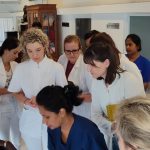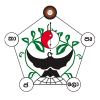Faculty of Complementary Medicines
Department of Acupuncture and Alternative Medicines
The Faculty of Complementary Medicines brings together Departments of Acupuncture & Alternative Medicines, Cosmetology, Homeopathy, Nursing across a spectrum of subjects and disciplines aligned to the natural medicine needs and requirements of today.
The popular programme in Acupuncture offered by Medicina Alternativa, is a four-semester course designed to provide students with a comprehensive understanding of acupuncture, its principles, and its applications in modern medicine.
Our course covers a wide range of topics, including the history and philosophy of acupuncture, acupuncture points and meridians, diagnosis and treatment planning, needling techniques, and acupuncture in modern medicine. We also provide hands-on training in acupuncture techniques, allowing students to practice their skills and gain valuable experience at our Teaching Hospital.
One of the key benefits of our acupuncture course is that it is approved by the Vocational Training Authority in Sri Lanka. This means that our course meets the highest standards of quality and is recognized by the government as a valuable training program for aspiring acupuncturists.
Those who complete the basic programme have the choice of continuing their studies until they complete the entire MD in Alternative Medicine programme which takes a total of 6 years including internship.
At Medicina Alternativa, we are committed to providing our students with the best possible education and training in complementary medicine. Our experienced global faculty members are experts in their fields and are dedicated to helping students achieve their goals.
Degree opportunities available: BSc, MSc, PhD in Alternativa and Natural Medicine
CLINICAL TRAINING AT OUR TEACHING HOSPITAL
Course Syllabus
Department of Acupuncture
HUMAN ANATOMY
HUMAN PHYSIOLOGY
BIOCHEMISTRY
ACUPUNCTURE – I
* History of Traditional Chinese Medicine and Acupuncture
* Basic theories of Traditional Chinese Medicine
* Concept of Yin and Yang
* Taoism
* Qi, Blood and body fluid
* Zang-fu organs and their relationship
* Five elements theory
* Mother-Son Law
* The Great Law of Bu-Xie
* Organ-clock theory
SAFETY AND STANDARDS, LAW AND ETHICS , CPR TRAINING AND FIRST-AID
Clinical Observation
GENERAL PATHOLOGY
MICROBIOLOGY
PREVENTIVE MEDICINE AND PUBLIC HEALTH
ACUPUNCTURE – II
1. Fundamental theories of Acupuncture and its applications
2. Traditional Chinese Medicine and diagnosis
3. Differentiation of Syndromes according to eight principles, Qi, blood and body fluid, Zang-fu organs, meridians and collaterals
4. Introduction of course and pathway of meridians
5. Acupuncture Meridians and Collaterals – Part I
Description of Location of Points, indications and needling, functional relationship, syndromes, pathological manifestations and clinical application of 14 meridians – Part I
• The lung meridian
• The large intestine meridian
• The stomach meridian
• The Spleen meridian
• The heart meridian
• The small intestine meridian
6. Technique of Acupuncture
7. Types of Needle
8. Needling technique
9. Clean needle technique
10. Sterilisation
CLINICAL OBSERVATION – I
1. Case Taking methodology
2. Record keeping
3. Practice management
4. Communication skill
WESTERN MEDICINE AND DIAGNOSIS – I
GYNAECOLOGY
PSYCHOLOGY AND COUNSELLING
ACUPUNCTURE – III
1. Traditional Chinese Medicine Diagnosis and its clinical applications
• Visual Diagnosis (Inspection)
• Tongue diagnosis
• Pulse Diagnosis
• Psycho emotional diagnosis
• Differentiation of Syndromes according to eight principles
• Differentiation of syndromes according to the theory of Qi and
blood
• Differentiation of syndromes according to the theory of Zang – fu organs
• Differentiation of syndromes according to the theory of meridians and collaterals
• Pathological manifestations of the twelve meridians
• Pathological manifestations of the Eight extra meridians
• Iridology Diagnosis (Eye Diagnosis)
2. Acupuncture Meridians and Collaterals – Part II
Description of Location of Points, indications and needling, functional relationship, syndromes, pathological manifestations and clinical application of 14 meridians – Part II
• The urinary bladder meridian
• The kidney meridian
• The Pericardium meridian
• The Sanjiao meridian
• The Gall bladder meridian
• The Liver meridian
THE EIGHT EXTRA MERIDIANS
• Du Meridian
• Ren Meridian
• Chong Meridian
• Dai Meridian
• Yanggiao Meridian
• Yinggiao Meridian
• Yangwei Meridian
• Yinwei Meridian
• Extra ordinary points and new points
3. Complications and Contraindications of Acupuncture
NUTRITION AND DIET
CLINICAL PRACTICE – I
1. Technique of Acupuncture
2. Needling method
3. Manipulation
4. Moxibustion
5. Patient assessment and treatment plan
6. Rules for Principles of point selection
7. Prohibited points
8. Location of Acupuncture points and needling
Semester IV
WESTERN MEDICINE AND DIAGNOSIS – II
(Practice of Medicine)
ACUPUNCTURE – IV
1. Therapeutics and applied Acupuncture
2. Cupping
3. Electro Acupuncture and TENS
4. Magnetotherapy
5. LASER Therapy
6. TUINA massage
7. Management of complication and contraindication
SCIENTIFIC BASIS AND MODERN THEORIES OF ACUPUNCTURE
8. Neuro-Physiology of acupuncture
9. Motor – Gate theory
10. Gate – Control theory of pain
11. Endorphin Release – Pain theory
12. Encephalin Theory of pain
13. The recent research in Acupuncture
14. Applied Acupuncture for disorders of different systems
15. Auricular therapy ( Ear Acupuncture)
16. SCALP Acupuncture
17. SU-JOK Korean Acupuncture
18. Cosmetic Acupuncture
19. Reflexology
20. Pain management and rehabilitation
21. Acupressure
CLINICAL PRACTICE – II
1. Case study and assessment of the patient
2. Diagnosing the case and syndrome differentiation
3. Reasoning the diagnosis
4. Analyzing the pathogenic factor
5. Comparative analysis with western diagnosis
6. Treatment plan according to the Traditional Chinese Medicine principles, syndrome differentiation and diagnosis
7. Acupuncture points prescription and needling
8. Advice / Educate the patient about follow-up, management, life-style changes
9. Application of ancillary methods – cupping, moxibustion, electro-acupuncture
10. EAR acupuncture
11. SCALP acupuncture
12. Cosmetic acupuncture
13. LASER therapy
14. TUINA Massage
15. Ayurvedic massage
INTEGRATED MEDICINE (OPTIONAL)
1. Homeopathy
INTEGRATED MEDICINE (OPTIONAL)
Brief study of
- Ayurveda and
- Herbology
- Homeopathy
- Naturopathy
- Nutrition and Diet
- Yoga
ACUPUNCTUR – V
- Applied Acupuncture for disorders of different systems
- Auricular therapy ( Ear Acupuncture)
- SCALP Acupuncture
- SU-JOK Korean Acupuncture
- Cosmetic Acupuncture
- Reflexology
- Pain management and rehabilitation
- Acupressure
CLINICAL PRACTICE – III
- EAR acupuncture
- SCALP acupuncture
- Cosmetic acupuncture
- LASER therapy
- TUINA Massage
- Ayurvedic massage
- Technique of Acupuncture, Needling method, Manipulation
- Patient assessment and treatment plan
- Rules for Principles of point selection
- Prohibited points
- Location of Acupuncture points and needling,
- Case study and assessment of the patient
- Diagnosing the case and syndrome differentiation
- Reasoning the diagnosis
- Analyzing the pathogenic factor
- Comparative analysis with western diagnosis
- Treatment plan according to the Traditional Chinese Medicine principles, syndrome differentiation and diagnosis
- Acupuncture points prescription and needling
- Cupping, moxibustion, electro-acupuncture
- EAR acupuncture
- SCALP acupuncture
- Cosmetic acupuncture
- LASER therapy
- TUINA Massage
- Ayurvedic massage
- Advice / Educate the patient about follow-up, management, life-style changes
- History, Philosophy and Principles of
- Alternative Medicines
- Aromatherapy
- Colour Therapy
- Hypnotherapy
- Gem Therapy
- Iridology
- Spiritual Healing
- Oriental Diagnosis
- Tibetan Medicines
- Meditation
- Comparative and In-Depth Study of Ayurveda,
- Homeopathy and Naturopathy
Clinical training in various departments
- Department of General Medicine
- Department of Neurology
- Department of Orthopedics and Trauma
- Department of Gynaecology
- Department of Dermatology
- Department of ENT and Ophthalmology
- Department of Psychiatry
- Department of Pain Management, Rehab and Sports medicine
- Workshops and Seminar
- Field visits
Academic Staff
Department of Acupuncture
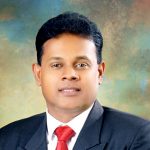
Dr. Saman S Hettige
Dip in Acu- the People’s Republic of China. PG Dip in Buddhist Ayurveda Psychiatry Counselling Nagananda Int’l Buddhist University – Sri Lanka EMSc -Executive Masters in Science (Malaysia) , MA Buddhist Ayurveda Counselling (Kelaniya) Senior Lecturer

Dr. Amila Jayasinghe
DA.SL, D.Ac., MACF,
PG Dip. in Buddhist Ayurveda Counselling,
MA - Buddhist Ayurveda Counselling,
MA - Buddhist Studies (University of Kelaniya)
Head of Department
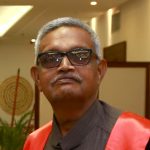
Dr. G. Sathyamoorthi
Acupuncturist & Chief Trainer TCM
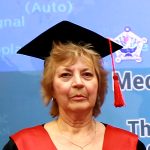
Prof.Dr. Dame Heather Wardell Johnson PhD., FRCP (MA)
Head of Faculty Professor of Cosmetology. Head of Faculty of Complementary Medicines
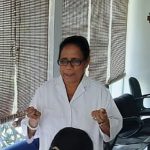
Dr. K. L. G. Amaranayake
DIMS/ MAcF
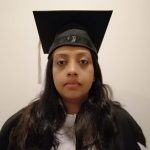
Dr. Wulakshi Wijekoon
MD( Russia) MD (A.M), Ph.D
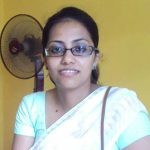
Dr. Uddika S. Dharmarathne
Dr.Uddika Shermini Dharmarathna M.B.B.S., Diploma in Acupuncture Senior lecturer at OIUCM

Dr. P. K. Chamashi Damindra Ranaweera
Ayurvedic Medical Practitioner Clinical Competency in Acupuncture - OIUCM IM & Mol. Bio - University of Colombo Dip.in Ayurvedic Beauty Culture (DIP.Ayur.B) - IICA Colombo Dip. in Counseling Psychology (DIP.Cou.Psy) - SAIIHE Dip.in Panchakarma (DIP.Pch) - SIATM Colombo Dip. in Orthopedic (DIP.Ortho) Ct.in Yoga - Ayush LI (SL), Patanjali Yogpeet(IND)
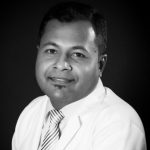
Dr. Bandula K. Galagedara
D. Ac. F,M. Ac. F, M. H. F
